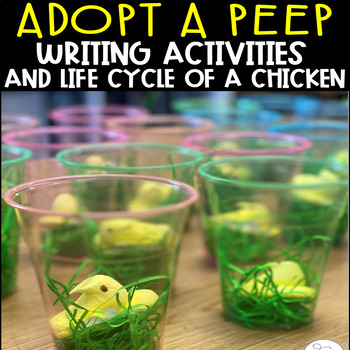Adopt a Peep Writing and Life Cycle of a Chicken
That Teaching Spark
19.7k Followers
Grade Levels
2nd - 4th
Subjects
Resource Type
Standards
CCSSCCRA.W.3
CCSSCCRA.W.4
NGSS3-LS3-2
NGSS3-LS3-1
Formats Included
- PDF
Pages
18 pages
That Teaching Spark
19.7k Followers
What educators are saying
My students absolutely loved this activity! It was very engaging and one they’ve talked about for a long time afterwards.
My students loved this activity. We did this when we returned from our spring break. It was so much fun!
Description
This highly engaging Spring Adopt a Peep writing and life cycle resource is a huge hit in my 3rd grade classroom! Students get to adopt a Chick Peep marshmallow, take care of it, write about its adventures, and even learn about a chicken's life cycle.
What's Included?
Teacher Ideas Page
Video Links and Read Alouds
Peep Adoption Certificate
Peep Birth Certificate
Adopt a Peep labels
My Peep Birth Story
How to Take Care of My Peep
My Peep Favorites
Chicken Facts Note Taking
Life Cycle of a Chicken (3 differentiated levels)
My Peep Adventure Writing (2 templates)
A Day in the Life of My Peep (2 templates)
My Peep Adoption Writing template
Total Pages
18 pages
Answer Key
N/A
Teaching Duration
N/A
Report this resource to TPT
Reported resources will be reviewed by our team. Report this resource to let us know if this resource violates TPT’s content guidelines.
Standards
to see state-specific standards (only available in the US).
CCSSCCRA.W.3
Write narratives to develop real or imagined experiences or events using effective technique, well-chosen details, and well-structured event sequences.
CCSSCCRA.W.4
Produce clear and coherent writing in which the development, organization, and style are appropriate to task, purpose, and audience.
NGSS3-LS3-2
Use evidence to support the explanation that traits can be influenced by the environment. Examples of the environment affecting a trait could include normally tall plants grown with insufficient water are stunted; and, a pet dog that is given too much food and little exercise may become overweight.
NGSS3-LS3-1
Analyze and interpret data to provide evidence that plants and animals have traits inherited from parents and that variation of these traits exists in a group of similar organisms. Patterns are the similarities and differences in traits shared between offspring and their parents, or among siblings. Emphasis is on organisms other than humans. Assessment does not include genetic mechanisms of inheritance and prediction of traits. Assessment is limited to non-human examples.





